Rodgersia—A Big Beauty
I was recently reading an article on low-allergen plants and came across a plant I haven’t thought of in quite some time, mainly because for some reason I haven’t tried to grow it since leaving Virginia 15(ish) years ago. Where I’m at in Zone 8a, it may not do well because it prefers Zone 4 to 7 environments with cooler summer temperatures and more winter chill hours.
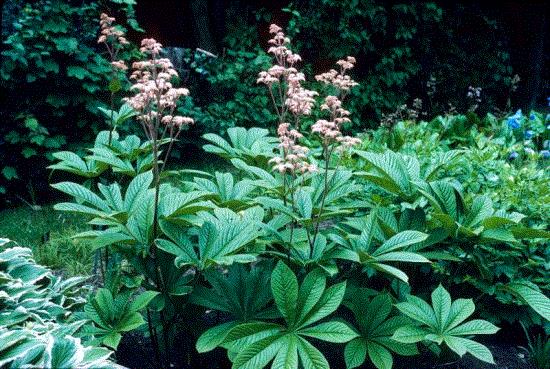
When it comes to texture and uniqueness, it's hard to beat Rodgersia pinnata.
Rodgersia pinnata has a lot going for it, but I was first attracted to the large, bold pinnately compound leaves that can measure more than a foot in diameter on a 4-ft. rounded perennial. In early summer, white bloom panicles rise above the foliage 2 to 3 ft. and provide three to four weeks of bloom. And if sited correctly, the foliage remains clean all season long, which is a nice late-season spark in a dulling landscape.
Now comes the tricky part: To really thrive, this species needs continuously moist soils. For that reason, you frequently find them in the edges of water features or in the splash-zone of a waterfall. They also do excellent around creeks. If the soil dries, the foliage will do the same! As for exposure, part sun to shade is preferred, but this isn't as critical as soil moisture.

Florence—Lasting Impact
It would be an understatement to say that Florence devastated more than a few nursery producers and landscape contractors in the Carolinas. I grew up in that area, and as of today (September 25, 2018)—nearly two weeks after landfall—the rivers are still so high in many locations that business owners haven't been able to assess damages yet. This is especially true along the immediate coast.
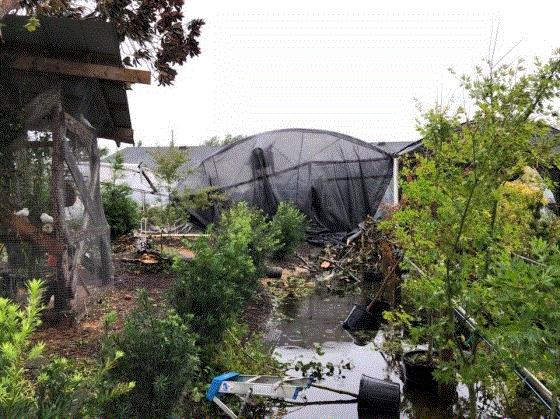
Scenes like this from Carolina Home & Garden in Newport, North Carolina are all too common. While it certianly could have been worse, it was pretty crappy nonetheless.
I've gotten A LOT of calls and emails from people who want to assist. I too am trying to put together a group of University of Georgia students for a weekend trip to assist. While things are still a bit chaotic, the first place I would start is by calling or emailing the North Carolina Nursery & Landscape Association. They're trying to coordinate assistance, including volunteers to assist in cleanup. Additionally, from what I've heard, the Cape Fear Botanical Garden also sustained heavy damages and may be in need of assistance.

Disaster Unemployment Assistance
One aspect of recovery that many people either don’t know about or ignore is the Disaster Unemployment Assistance (DUA) program. This federal program provides unemployment benefits to individuals who have become unemployed as a direct result of a Presidentially declared major disaster, which Hurricane Florence was in North Carolina, South Carolina and Virginia.
In order to qualify for DUA benefits, your employment or self-employment must have been lost or interrupted as a direct result of a major disaster declared by the President of the United States. Also, you must have been determined not otherwise eligible for regular unemployment insurance benefits (under any state or Federal law).
Payment will be made to an unemployed worker (or business owner) who as a direct result of a Presidentially declared major disaster:
-
No longer has a job
-
Is unable to reach their place of work
-
Cannot work due to damage to the place of work
-
Becomes the head of the household and is seeking work because former head of household died as a result of the disaster
-
Cannot work because of a disaster-incurred injury

Wage & Benefit Survey Time
The readers of this newsletter are pretty amazing when it comes to providing feedback, even if some of it suggests I should consider a career shift into cattle sanitation. I’m hoping you can come through again and assist us with an extremely important and valuable survey.
Each year, Ball Publishing conducts two wage and benefit surveys—one directed to growers and a second to those who have a retail component to their business. Results of both are published in GrowerTalks/GreenProfit magazine thanks to the survey sponsor, Florasearch.
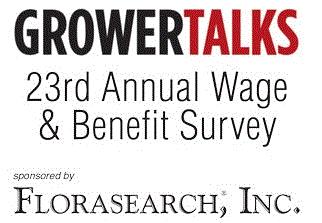
Now, while I can beg you to take the survey, it always helps to sweeten the deal. So take our survey and you could win the newest iPad! If you enter your email at the end of this survey, you’ll be eligible for a drawing to win a 128GB iPad—the newest version that’s compatible with Bluetooth keyboards and the Apple Pencil! Only those that provide their email address will be eligible to win the prize. (Don’t worry—we’re not going to keep your address or give it to a third party.)
Thanks for your support in this effort!

H-2B Worker Announcement
On September 12, the U.S. Department of Labor issued a press release that announced a “nationwide initiative to strengthen compliance with the labor provisions of the H-2B temporary visa program in the landscaping industry.” This comes on the heels of a similar announcement regarding the hospitality industry last month.
So what does this mean for landscape contractors? If you’re not utilizing the H-2B program, it means nothing. If you do use the H-2B program, I would prepare for an audit. There seems to be two focus areas of this announcement, both related to program compliance. The first is confirming an insufficient number of U.S. employees are qualified and available to work in your area. The second is confirming the employment of H-2B workers will not adversely affect the wages of U.S. workers.
Ursula’s Red Japanese Painted Fern
First, what a cool name! It’s not the most creative name, however, as it was discovered by Ursula Hertz, a perennial grower in South Carolina. And Ursula, in case you were wondering, had quite the eye for the cool and unusual. Case in point, Liriope muscari Peedee Ignot, which she also introduced to the trade (it's my favorite liriope cultivar).
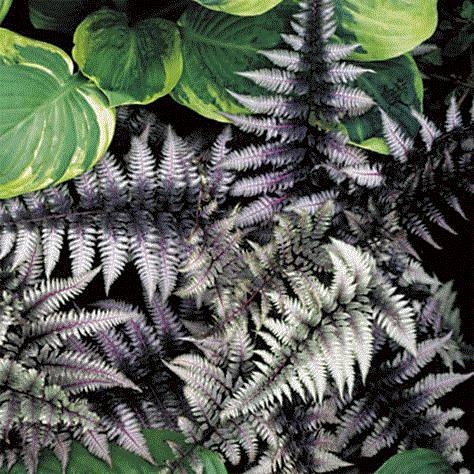
But I digress … again. Ursula’s Red Japanese painted fern (Athyrium niponicum) is both unusual and practical. Being hardy from Zone 4a to 9a opens it up to a wide market, with many a garden in need of a splash of color in the shadows. And while similar to the species, this cultivar boasts a distinctive wine-red rachis (mid rib of blade) that fades outward for about an inch onto the pinna (leaflets). It’s quite a bold and unusual color for the shade garden and would contrast well with the chartreuse foliage of … let me think … Liriope muscari Peedee Ignot.
See what I did there? Yep—I just laid out an Ursula’s garden walk for you.

MANTS Registration Opens
That’s enough on labor for one newsletter! How about something fun to daydream about … like a huge tradeshow.
The Mid-Atlantic Nursery Trade Show (MANTS) is returning to Baltimore again January 9-11, 2019 for their 49th annual event and registration is now open. Green industry companies and businesses interested in exhibiting or attending The Masterpiece of Trade Shows may register online at www.MANTS.com.
As someone who has attended MANTS for many years, I can attest that this show is worth the cost and time to attend. Hotels in the area fill pretty quickly, as there will be approximately 12,000 attendees, so make sure to book your spot soon.
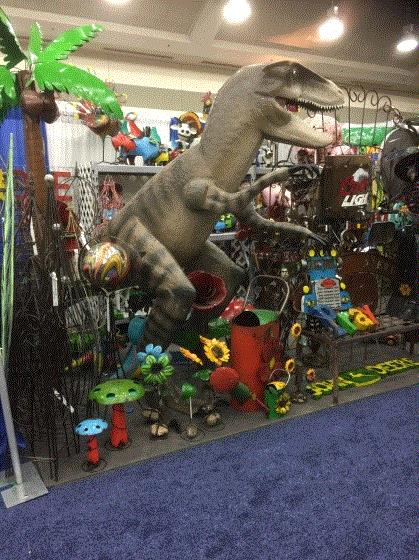
Ahhhh, MANTS, where prehistoric creatures roam the halls ...
And while you’re booking your MANTS registration, don’t forget that the Southern Nursery Association Conference will be January 7-8, in the same location. So you can show up a day or two earlier and learn about new plants and new research that directly benefits nursery/floriculture operations.
See you there, if not sooner.

Our Wacky Wonderful World—Notes from the Edge of Sanity
My grandfather never passed a penny laying on the ground that he didn’t pick up. I’d like to say I didn’t either, but I've been known to when I’m in a hurry. I was recently conducting a Cooperative Extension program and had a group of nursery folks all standing in a cold frame with black landscape fabric covering the floor. I noticed a shiny penny sitting right there in plain view. Do you think anyone picked up the penny? Nope … until I walked back in and did so.
But first, we exited the cold frame and I stopped them and asked, "Who saw the penny on the floor?" Of 16 participants, 12 said they had. I asked why didn’t they pick it up? I received two responses: “It’s only a penny” and “I didn’t want to interrupt you.”
Both of these, while interesting and valid, were also quite disturbing. First, a penny is equal to a 1% profit laying right there on the floor. If your contracting firm or nursery has a gross profit of $100,000, that penny on the floor is now equal to $1,000. Is it still unimportant? I certainly hope not.
Second, sometimes a business needs to disturb the peace to make that extra 1% profit. No business has ever grown market share without disturbing (negatively) a competitor. If someone wants to leave that 1% on the floor, you better believe someone is going to see the value in it and bend over, regardless of who’s watching. I’d hope that person is you. At some point in the life of a business, it will separate failure and success.

Live authentic,

Matthew Chappell
Editor-at-Large
Nursery & Landscape Insider
This has been received by 30,374 of the hardest-working horticulturists in show business!
If you're interested in reaching 30,374 (and growing) clients who eagerly await every Nursery & Landscape Insider and surely read every word, contact Kim Brown ASAP and she'll hook you up. And thanks for helping us reach a community of 30,000+ fellow horticulturists! Keep spreading the word.